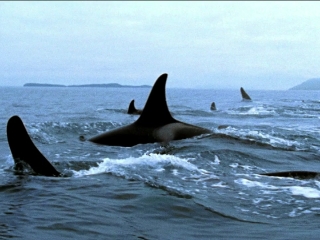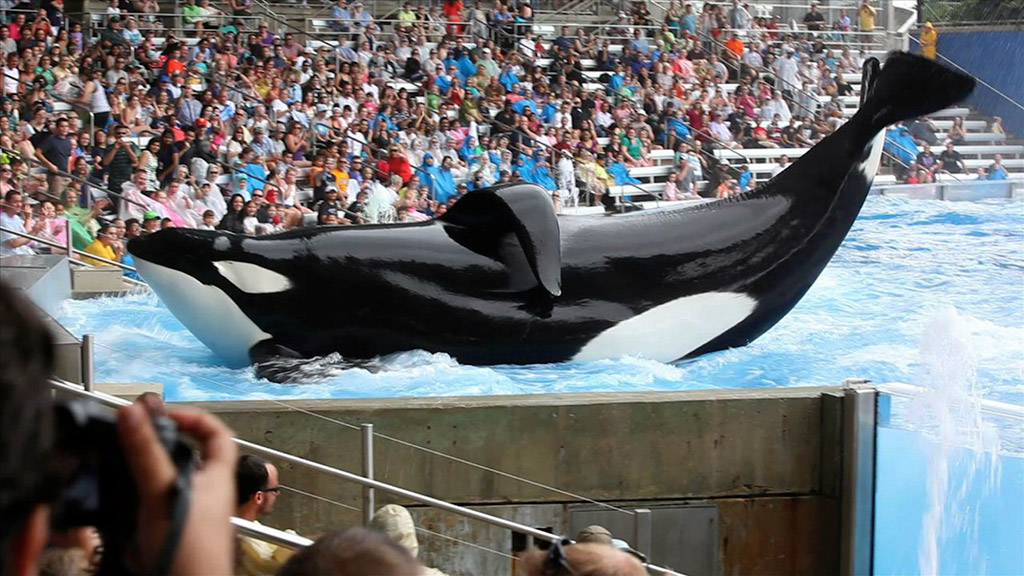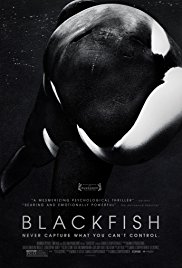BLACKFISH
SUBJECTS — the Environment;
SOCIAL-EMOTIONAL LEARNING — Caring for Animals;
MORAL-ETHICAL EMPHASIS — Responsibility.
AGE: 13+; MPAA Rating — PG-13;
Documentary; 2013, 81 minutes; Color.
MENU
MOVIE WORKSHEETS & STUDENT HANDOUTS
Documentary which Seeks to Persuade on Issues of Political or Social Significance.
Teachers can modify the worksheets to fit the needs of each class.
DESCRIPTION
This film presents the case against keeping orcas (killer whales) in captivity. It also asserts that SeaWorld Entertainment (the operator of several marine mammal parks in the U.S.) misleads the public and that SeaWorld put its employees at risk by requiring them to perform with orcas. The film explores the circumstances of the 2010 killing of trainer Dawn Brancheau by the orca Tilikum which resulted in a citation by the Occupational Health and Safety Administration (OSHA) and an order requiring physical barriers between trainers and orcas. SeaWorld Entertainment has appealed the decision.
SELECTED AWARDS & CAST
Selected Awards: Awards season for this film is not yet completed.
Featured Actors: Tilikum, Dave Duffus, Samantha Berg.
Director: Gabriela Cowperthwaite
BENEFITS OF THE MOVIE

Blackfish provides startling revelations about the marine mammal exhibition industry and particularly the operations of SeaWorld Entertainment. The film raises important questions about the way people treat marine mammals and, by extension, all wild animals confined in zoos and animal exhibition parks.
Students will have an increased awareness of an important issue now being debated in the public conversation. They will discuss and write about topics relating to the appropriate relationship between people and non-human animals. They will also develop skills in the analysis of contending positions and of documentary films.
POSSIBLE PROBLEMS
None.
PARENTING POINTS
Watch the movie with your child and pick a discussion question to discuss after the movie.
USING THE MOVIE IN THE CLASSROOM

Introduction to the Movie
This film needs no introduction and provides its own factual background. Before showing the movie, review, print, and distribute to the class TWM’s Movie Worksheet for Blackfish. Go over the worksheet with students before starting the movie and allow them two five-minute breaks during the film and one at the end of the movie to make notes for their responses. Consider having students write out full responses to the prompts on the Worksheet as homework for the evening after the film has been shown and discussed.
After the Film
Following a short break to allow students to finish their notes for the Movie Worksheet, engage the class in a discussion about the issues raised by the film. Before the discussion, consider telling the class or have a student give the class a report on experiences with wild animals which do not involve placing them in captivity. Examples include: wild dolphin safaris in the Bahamas in which people can swim and play with Atlantic Spotted Dolphins; Petting Whales in Baha Sur California where people pet the baby whales as the mothers, who were petted themselves when they were young, stand watchfully by allowing their offspring to have this cross-species experience; and Stingray City, Grand Cayman where stingrays come to be fed and allow people to kiss and hold them. In each of these experiences, animals are living freely yet willingly come into contact with humans. Also, in many tropical locations, there are tours which take tourist to coral reefs and allow them to attract fish with food. Note that these experiences involve travel to foreign countries which may or may not be more expensive than a trip to a marine mammal park.
DISCUSSION QUESTIONS
Tell students that they can use anything said during the discussion to help them respond to the prompts on the Worksheet. For the discussion questions in this Guide there is no one single correct response.
1. Orcas are intelligent and emotionally complex creatures who can swim more than 100 miles in a day when necessary to forage for food. They live in multigenerational matrilineal family groups and engage in intricate communal rituals that provide stability and foster cooperation. They communicate in ways that may be similar to language. Like most mammals, they have periods of play. Given these facts, is it right to confine orcas to small concrete or metal tanks and make them entertain human audiences in order to get food?
Suggested Response:
A strong discussion will raise the following points:
(1) detriment to the orcas, such as loss of freedom and the ocean life they were born to live, disruption of orca family relations and loss of loved ones, shortened life expectancy, emotional problems, and stress-related illnesses (orcas in captivity generally die from stress-related diseases and grind down their teeth because they gnaw at the gates and walls of their enclosures);
(2) humans are entertained — however, note that animals kept in confinement removed from their families and natural habitat act differently than animals in the wild therefore marine mammal exhibitions and zoos show a distorted view of what the animal is really like;
(3) benefits to the orca species as a whole by virtue of the fact that orca exhibitions heighten human awareness of killer whales fostering conservation efforts;
(4) funds from marine mammal exhibitions are sometimes used to fund conservation and research activities — the questions are how much goes into research, how much is kept for profit, how much is spent on salaries for the people who work and manage the companies that hold the marine mammal exhibitions and how much is taken as profit (SeaWorld Entertain is a multi-million dollar for-profit corporate enterprise); and
(5) some of these arguments do not apply to orcas born into captivity since they have not experienced the open oceans and probably could not survive in the wild, although (a) orcas born into captivity die as early as orcas caught in the wild and then confined and (b) orcas born in captivity die of the same stress-related diseases as wild orcas caught and then confined; also like people born into slavery, some will argue that it might have been better had the orcas born in captivity never lived — note that some slaves in the American South tried to avoid having children because they didn’t want them to be born into slavery.)
During the discussion, teachers may want to read the following quote from the film. The words were spoken by neuroscientist Dr. Lori Morino, a critic of SeaWorld Entertainment.
The orca brain just screams out intelligence, awareness. We took this tremendous brain and put it in an MRI machine. . . . What we found was just astounding. They’ve got a part of the brain that humans don’t have; a part of their brain has extended out right adjacent to their limbic system, the system that processes emotion. The safest inference would be [that] these are animals that have highly elaborated emotional lives. It’s becoming clear that dolphins and whales have a sense of self, a sense of social bonding that they’ve taken to another level, much stronger, much more complex than in other mammals, including humans. . . . It’s been suggested that their whole sense of self is distributed among the members in their group.
As the discussion progresses, teachers can pose additional questions, such as:
(A) What do you think of the argument that zoos and marine mammal exhibitions involve the suffering of relatively few animals but often benefit large numbers of other animals?
and
(B) Instead of confining the orcas wouldn’t it be better to invest in technology that would allow people to enjoy “virtual” interactive experiences with animals but still provide funding for rescue and research?
Note also that the same type of question can be asked about the operations of any animal exhibition such as zoos. One point of difference is that while orcas are not an endangered species, many zoos have special breeding programs for endangered species which are the only way that those species are expected to survive extinction.
2. What do you think of the way that the managers at SeaWorld Entertainment dealt with the trainers employed by the company?
Suggested Response:
A good discussion will address the following issues:
1) whether the managers provided full disclosure of the risks of the job;
2) whether SeaWorld Entertainment provided adequate protection for the trainers;
3) the fact that working with confined wild animals has obvious risks, that there was some disclosure, and that the trainers should not be able to complain that they were not told of every fact; 4) the fact that many of the fatalities appear to have been caused by one whale, Tilikum; and 5) the fact that Tilikum’s sperm has been used to impregnate many whales and that his aggressive tendencies might be inherited by his offspring – although a strong case can be made that Tilikum’s aggressiveness is the result of his confinement and the abuse that he suffered at the hands of humans and other confined whales.
3. Are the trainers complicit in the way SeaWorld treated its orcas? One said he stayed around just because of compassion for the orca? Does that make sense?
Suggested Response:
The trainers have some complicity because they earned their living by training the animals and facilitated SeaWorld’s activities. The fact that the trainers were not given full disclosure about some of the problems, such as the other incidents of killings by orcas or that orca life expectancy may be reduced in captivity is a mitigating factor, but the trainers knew that the orcas were taken out of the wild and lived in relatively small tanks. As professionals, they knew and should have known, the importance of the orca family structure that had been disrupted, of the orca-on-orca violence that occurred in captivity, etc. Others have criticized SeaWorld Entertainment for using the love the trainers had for the orcas as leverage in dealing with the trainers and getting the trainers to do things the trainers would not otherwise have done.
4. Do people who have control over animals have a responsibility to consider the interest of the animals? Does it make a difference if the animals are captured in the wild like the orcas, if they are pets like dogs and cats, or if they are domesticated animals bred for food like pigs, sheep, and cows?
Suggested Response:
Teachers should help students to understand the analysis of some philosophers of the school of philosophy called Utilitarianism. They contend that the life and pain of an animal has some value in moral decisions and that the purpose of ethical action is to balance the interests of all sentient beings affected by the action in order to maximize pleasure and happiness while minimizing discomfort and suffering. Following this reasoning the question is whether the benefits to humans in watching the orca exhibitions are equal to or greater than the harm to the orcas who are required to perform in those shows. Other considerations include the benefits to orcas in the wild due to the fact that the shows build empathy for the animals and foster conservation efforts and the value of any research or rescue efforts paid for with the income generated from such shows. In this discussion, students should also be exposed to the argument that the importance of an animal’s interest in freedom and in living in the environment to which they are genetically adapted is greater in more intelligent animals such as cetaceans, apes, chimps, dogs, pigs, etc. than in more primitive forms such as worms, mollusks, and shrimp.
5. Tilikum has been involved in the death of more than one person. What should happen to him? For example, should he be put down, returned to the open ocean, be sent to a whale sanctuary, or perform again with increased protections for the trainers?
Suggested Response:
Strong responses will note the following: Responsibility for the deaths lies with the people who captured, confined, and trained Tilikum, controlled his environment, and placed the trainer in a position of risk. There is no justification for ending his life as punishment. He is not a public nuisance, and if people don’t place themselves in proximity to him there is no risk that he would kill again. A whale sanctuary would have to be a large bay so that he could swim freely but with a barrier to prevent him from going out to sea. It is doubtful that he could live in the wild after all the years he has spent in captivity. But there are problems with this approach. First, SeaWorld Entertainment would have to pay for this, and it would be unlikely to do that since it would depress corporate profits. Second, would Tilikum be a risk to other animals, including people, who would also want to use the bay? Note that there is no reported instance of killer whales in the wild hurting people. Another option would be to put Tilikum back into the SeaWorld Entertainment shows on a limited basis. SeaWorld Entertainment argues that this would be better for Tilikum because it would allow him to socialize and give him something to do. It would also allow the company to realize more revenue on its investment in the orca. Some may also argue the if there are insufficient funds to pay for a sanctuary, as a practical matter, Tilikum should be killed; it would be better for him than a life confined to small tanks. When the discussion is over the teacher should inform the class about the current status of Tilikum. As of 12/31/13 SeaWorld Entertainment has placed Tilikum back into the shows on a modified basis. In these shows, pursuant to the OSHA ruling, trainers are not in the water with the orcas.
6. What about a dog that had been abused in the past and who has attacked and killed a person? What should happen to that animal? Explain the differences for the treatment suggested for Tilikum and the treatment you would suggest for the dog?
Suggested Response:
Good responses will raise many of the following issues. Dogs are domesticated animals and normally live in proximity to people. They often cannot survive in the wild nor would they be happy there. A sanctuary is a possible choice, but there would have to be protections so that the dog did not escape and kill again. Dogs are mobile on land while orcas are mobile only in water and kill people only when confined. Some would say that dogs (and orcas?) don’t have a conscience nor do they understand morality but then many people act as if they don’t have consciences and as if they don’t understand morality. A key issue is protecting people from attacks in the future and an argument could be that the best way to do that is to put the dog down, however, some dogs can be rehabilitated so that they are not violent. Is a person’s life worth the risk that a dog will not be properly rehabilitated? What is the worth of a dog’s life? One of the major differences between dogs and orcas is that orcas trained to perform are rare and involve a very large monetary investment, while dogs are plentiful and inexpensive.
If the class has not filled out TWM’s Movie Worksheet for Blackfish, additional discussion questions can be found on that document.
ASSIGNMENTS, PROJECTS & ACTIVITIES
Any of the discussion questions can serve as an essay prompt.
1. Have students complete the Movie Worksheet using their own reactions to the film and anything that was mentioned in class discussion.
2. Write a review of the film.
CCSS ANCHOR STANDARDS
Multimedia: Anchor Standard #7 for Reading (for both ELA classes and for History/Social Studies, Science, and Technical Classes). (The three Anchor Standards read: “Integrate and evaluate content presented in diverse media, including visually and quantitatively as well as in words.”) CCSS pp. 35 & 60. See also Anchor Standard # 2 for ELA Speaking and Listening, CCSS pg. 48.
Reading: Anchor Standards #s 1, 2, 7 and 8 for Reading and related standards (for both ELA classes and for History/Social Studies, Science, and Technical Classes). CCSS pp. 35 & 60.
Writing: Anchor Standards #s 1 – 5 and 7- 10 for Writing and related standards (for both ELA classes and for History/Social Studies, Science, and Technical Classes). CCSS pp. 41 & 63.
Speaking and Listening: Anchor Standards #s 1 – 3 (for ELA classes). CCSS pg. 48.
Not all assignments reach all Anchor Standards. Teachers are encouraged to review the specific standards to make sure that over the term all standards are met.
LINKS TO THE INTERNET
Note that new web pages on this controversy will be posted on the Internet as time goes on.
- SeaWorld is so pissed over Blackfish on gawker.com;
- Killer Controversy — Why orcas should no longer be kept in captivity by Naomi A. Rose, Ph.D., 2011;
- 8 Reasons Orcas Don’t Belong at SeaWorld from SeaWorldofhurt.com;
CRITICISM OF THE MOVIE
- Why Blackfish is Misleading, Unoriginal, and ‘Stupid’, a critical review;
- An Open Letter BACK to SeaWorld, December 20, 2013 ;
- SeaWorld responds to questions about captive orcas, ‘Blackfish’ film updated 11:27 AM EDT, Mon October 28, 2013; ;
- My Problems With Blackfish by Brad Brevet 11/4/13>;
This Learning Guide written by James Frieden and Deborah Elliott and was published on December 31, 2013.
Search Lesson Plans for Movies
Get our FREE Newsletter!
* we respect your privacy. no spam here!


